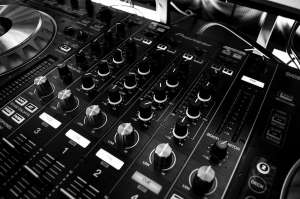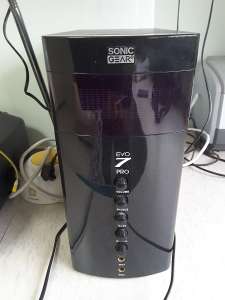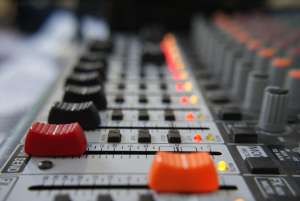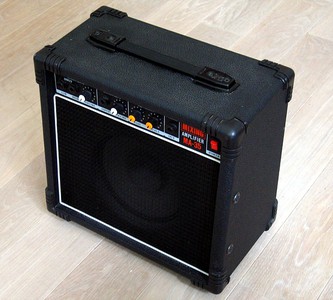Mixers and speakers go together like chocolate and milk. There’s no point using a mixer if there isn’t some kind of a speaker at the end of the equation.
But what about powered mixers and powered (active) speakers? They both amplify audio signals, so would it be safe to use a powered mixer with powered speakers?
It is generally unsafe to connect the outputs of a powered mixer to powered speakers. The already-amplified signal from the mixer could be too strong for the speakers to handle, causing severe damage to your equipment. But if you have a passive output on your mixer, that is a safe option to use.
The general rule is not to use powered mixers with powered speakers. But due to the rising popularity of both powered mixers and active speakers, equipment manufacturers have started to make provision for the possibility by adding particular capabilities to their mixers and speakers, so the answer isn’t always so clear-cut anymore. Let’s investigate it more closely.

Keep track of all your music and notes in one convenient place!
Over 1000 sold to songwriters everywhere – with a 5-star rating.
Why Can’t You Use A Powered Mixer With Powered Speakers?
In both the mixer and the speakers, you can easily replace the word “powered” with “amplified.” A powered mixer uses power to add some amplification to the signal before passing it along.

This amplification can sometimes be pretty potent, but this depends on the mixer. But this is so that you can connect the mixer directly to passive speakers since the signal is already amplified to an extent.
What makes powered speakers “powered” (or “active”) is the fact that they have amplifiers built into the same speaker cabinet. You essentially buy a speaker/amplifier combo.

The problem is that this equation leaves us with one too many amplifiers. Amps simply aren’t made to accept and process such a substantial input.
So if you were to connect your powered speakers to your powered mixer, one or both of the devices would overheat, blow a fuse, or damage components, depending on the strength of the signal and the quality of the speakers and mixer.
How To Use Powered Mixers With Powered Speakers
In the end, the only way for you to use a powered mixer with powered speakers is by bypassing one of the built-in amplifiers. You can do this on the mixer or the speaker.
Bypass The Amp In A Powered Mixer
Mixers are often the easiest to bypass. Most powered (amplified) mixers already have output connectors that bypass the mixer’s built-in amplifier completely. These connectors are often labeled “Record,” “Line,” or “Pre-Amp” on the mixing board.

If you use any of these connectors to hook up your powered speakers, you should have no problems with either the speakers or the mixer taking damage since the mixer’s amplifier will be removed from the equation.
Bypass The Amp In A Powered Speaker
This is a bit more of a technical process and could void your speaker’s warranty, so ponder that carefully before attempting it. If you could bypass the amplifier in your active speaker, that would allow you to connect it with your powered mixer (or any other amplifier, for that matter) and use it safely.

The only thing you have to do is open the speaker and locate where the input wires go into the amplifier. If you re-route them from this point to bypass the amp and connect them directly to the speaker cone, you have turned your powered speaker into a passive speaker that you can safely use with your powered mixer.
From this point, it wouldn’t even be too difficult to install a few switches that can let you select the mode in which you want to operate the speaker. That way, you will have the best of both worlds. The problem is that this is an awful lot of effort to go through, and as mentioned, it could void your warranty, so maybe use this option as a last resort.
Do You Even Need A Mixer If You Have A Powered Speaker?
This is a question that is far too often overlooked. If you have powered speakers, do you even need a powered mixer or any mixer at all?
It will depend on your needs, but remember that powered speakers have (very limited) mixing capabilities built in. You can usually connect a microphone directly to the speaker and control its volume and gain, while you can often also control the volume of the other input separately.

Yes, you are limited to using only two (or maybe three) inputs, and the quality probably won’t be as excellent as it could be if you used a good mixer. But in some cases, this could still be a better solution than trying to force a powered mixer to work with powered speakers and damaging your equipment in the process.
Some powered speakers are even made for this purpose to some extent, and it might be worth examining your speaker. Some brands (such as JBL) are known for building multiple input channels (usually up to four or six) directly into their powered speakers, each with its own separate volume control.
These won’t be sufficient for a band performing live in a large room or auditorium, but it could be a simple solution for one musician with a microphone and a direct instrument input. It’s also ideal for situations where you only have one person speaking over a microphone, like outdoor weddings.
Does The Same Apply To An External Amplifier?
Regardless of where an amplifier is located, the same rule applies: it’s generally not a good idea to use more than one amplifier, and chances are that something will get damaged.

Having said that, some modern amplifiers have built-in switches that can allow them to accept slightly amplified signals coming in from a powered mixer, for example. In these situations, it will be safe to use a powered mixer and a dedicated external amplifier together.
However, feeding that amplified signal into a powered speaker will be even worse than connecting it directly to the powered mixer. So if you have an external amplifier, don’t use powered speakers.
To summarize, the rule of thumb is to have only one proper amplifier in your setup. If the amp is in the powered mixer, use passive speakers. If the mixer isn’t powered, or if you’re using the passive outputs, then use active speakers. If you don’t have amps in either one of these, use an external amplifier.
The following table summarizes the scenarios for powered & non-powered mixers and speakers:
| Mixer & Speaker | Speaker without power (Passive) | Powered Speaker (Active) |
|---|---|---|
| Mixer without Power | Use an external amplifier. | OK, no external amplifier |
| Powered Mixer | OK, no external amplifier | Do not use this combo! |
it can be in the mixer, the speaker, or an
external amplifier, but never more than one.
Conclusion
Powered mixers and powered speakers make life much easier. In the past, engineers had to lug around three heavy pieces of equipment for a simple setup.
These days you can get by with only one active speaker with everything you need built-in. As you get more gear, remember not to overdo it with the amplifiers, and you should get years of service from your mixer and speakers.
You can learn how to connect a non-powered mixer to a powered one here.
You can learn about which mixers have the best effects here.
You can learn about some of the best cheap mixers available here.
You can learn about 2-way vs 3-way speakers here.
